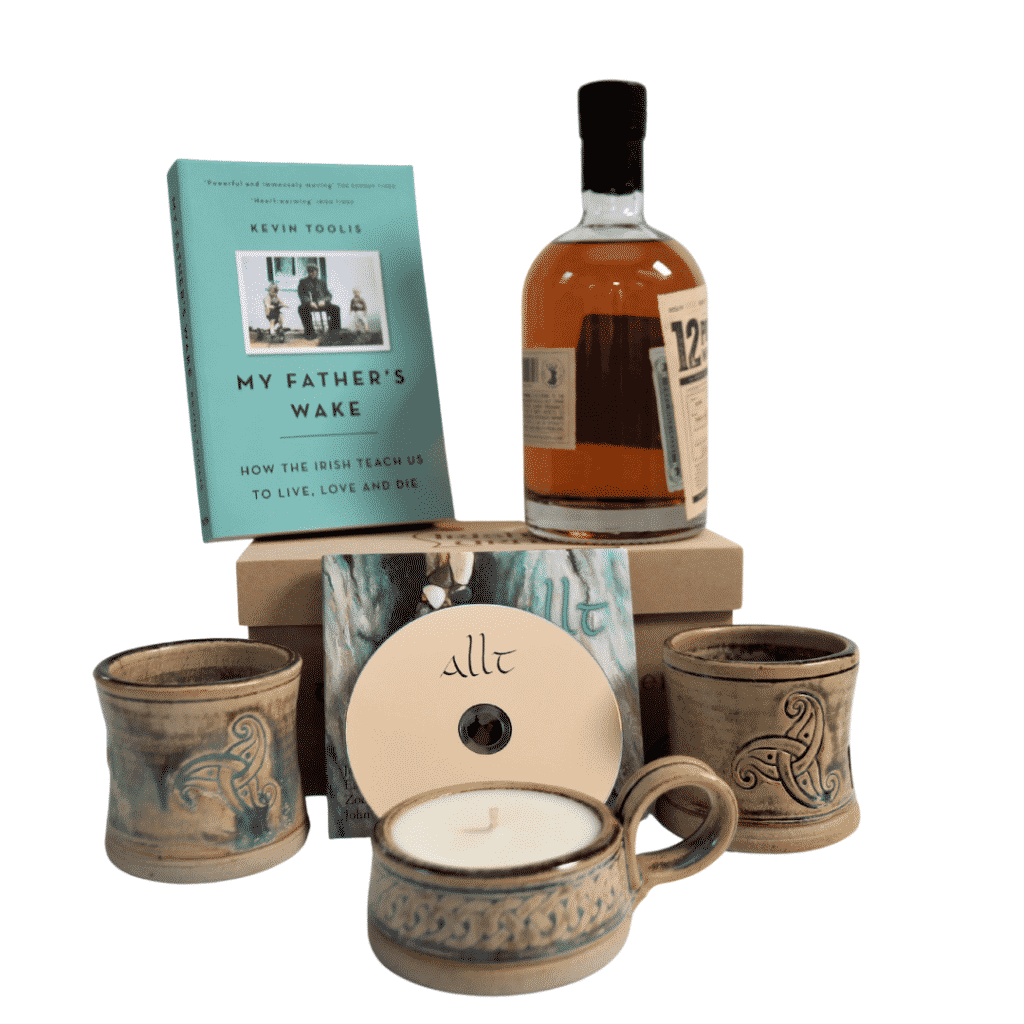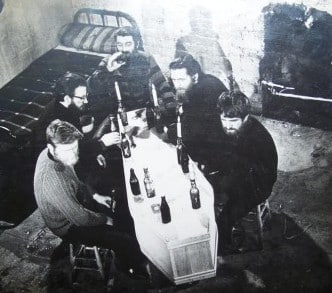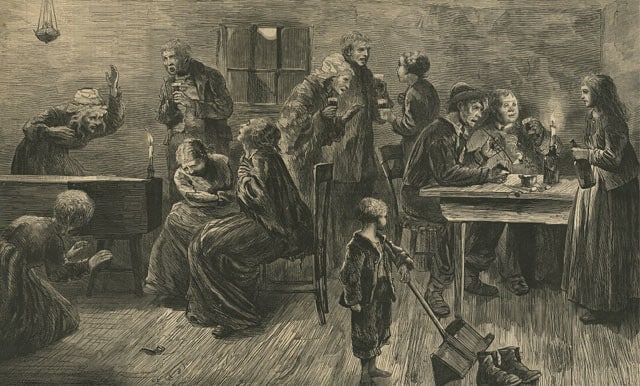The Irish Wake – Ireland’s Most Enduring Tradition
The Irish are a people well-versed in tragedy and suffering. Beset by famine, poverty and colonization, the history of Ireland is one that is steeped in immense adversity and sorrow. Perhaps this is why the Irish are so particularly adept at mourning the loss of a loved one and saying goodbye. There are many unusual customs and traditions which are unique to the Irish, but the Irish Wake is one of the most distinctive and renowned funeral traditions world-wide.
The Irish Wake may seem slightly peculiar or strange to those from other countries. For the Irish, however, it is a widely recognised ritual of death and grieving that has long been an inextricable part of the culture and heritage of Ireland. Nevertheless, there is no denying that the Irish Wake is unusual in a number of ways, not the least of which being the atmosphere. It is often a bittersweet experience that can encourage laughter as much as it can tears.
The feel and tone of an Irish Wake can be both heartrendingly mournful and joyously commemorative, sometimes simultaneously. It is not just an opportunity to grieve and process the pain of loss but also to celebrate and honour the gift of life. This is why alcohol and music, both significant staples of Irish culture, are often heavily featured at a wake. This unique mixture of melancholy and mirth is partly why the Irish Wake is so famous the world-over. Such an atmosphere is especially likely if the deceased was elderly or ill for a long period of time.
In the instance of the death of a young person or child, however, a wake is decidedly more sombre, solemn and restrained. Despite some elements of an Irish Wake which may be a bit more spirited than other funeral customs and traditions, it is always deeply respectful to and mindful of the deceased and their immediate relatives. The tone of the wake will always be appropriate and fitting for the circumstances surrounding the death in question.
The Irish Wake can be as much a social gathering as anything else. People converge in the home of the deceased to meet and greet one another, perhaps for the first time in many years. It can be a curiously apt setting for strengthening bonds and reuniting with old acquaintances, as people reminisce and trade stories of the loved one lost and times gone by.
People’s pretences and defences are often lowered in the face of grief which can leave them more vulnerable and open to moments of genuine connection and emotional honesty. Feeling strongly connected and close to those around you can be incredibly life-affirming. It can also help centre and ground you in the midst of grief.
While an Irish Wake is first and foremost a final farewell to the one departed, it can also serve as a potent and bracing reminder to those in attendance that they are still alive and a part of the world. This might be why an Irish Wake is occasionally quite a lively affair.
The exact origins of the Irish Wake are unclear, possibly forgotten completely or lost in time. But what is clear is that this ritual of death has been an integral part of Irish life for countless generations. It is widely believed that the Irish Wake was heavily influenced by elements of Paganism and may have originated with the Ancient Celts. The Celts believed in life after death and thought that when a person died, they then moved onto a better life.
The Ancient Celts, therefore, saw death only as a new beginning and treated it as a cause for celebration and festivities. It is easy to see how these customs may have influenced the traditional Irish Wake. However, there are those who think that the origins of the Irish Wake go back even further than the time of Paganism, into an indeterminate and obscure period of ancient history.
Some historians claim that the earliest evidence of a wake can be found in the ancient Jewish custom of leaving the sepulchre (or burial chamber) open and unsealed for three days. This was done to ensure that the person in question was most definitely dead before closing the chamber permanently. During these three days, family and close friends would visit the body repeatedly in the hope of seeing it return to life. Ultimately, though, they would pay their respects and say their final goodbyes.
Some believe that the term ‘wake’ originates from the practice of mourners keeping a watch or vigil over the body all through the night until it was buried. In olden times, the body of the deceased was never left alone until after burial, lest it fall prey to evil spirits and roaming demons. Lighted candles were placed closely around the body and clay pipes of tobacco and snuff were smoked continuously by male attendees during the vigil as they stood guard.
It was believed that the smoke would help keep malicious spirits at bay and stop hungry demons from finding the deceased and stealing the soul. In another effort to thwart the scheming, pernicious demons, clocks were often stopped immediately at the time of death and mirrors were covered in a shroud or turned to face the wall. This was done to allow the soul to travel safely to heaven, as it was believed in Irish folk legend that mirrors could act as gateways to other worlds.
There is one story which purports to explain the origins of the Irish Wake. Some say that both the tradition and the term of the wake in Ireland were borne from incidents involving lead poisoning during ancient times. Long ago in Ireland, pewter tanks and cups were used to hold beer, stout, wine and other beverages. These pewter tanks contained lead which then caused lead poisoning in those who drank from them.
It was said that this poisoning could induce drinkers into a catatonic or sleep-like state which closely resembled death until they abruptly woke up a few days later. So, in order to ensure that a person was actually dead and not just in a catatonic state or deep sleep, people would stand watch over a body for several days before burial and wait for it to possibly reawaken. However, while intriguing, this story is almost definitely myth or part of ancient Irish folklore.
Whatever the mysterious origins of the Irish Wake may be, it remains a prominent feature of Irish funerals all these centuries later. However, there is some concern that the Irish Wake is dwindling in prevalence in some regions and not as widespread throughout the country as it once was. Indeed, there is no doubt that wakes are far less common in Irish cities and metropolitan areas than in preceding decades. As these parts of Ireland are rapidly modernised and progress into the future, the ways of the past and old Ireland are left behind and replaced.
This is precisely why the Irish Wake is such a unique and significant experience. It is a relic from a time that, in many ways, no longer exists and must be preserved and respected in order for us to retain and pass on our Irish heritage. Thankfully, in most areas outside of cities, the Irish Wake is a custom which is still revered and upheld by many in Ireland today. It is an opportunity to mourn the loss and celebrate the life of a loved one in equal measure, as they depart from their home for the final time. It is a uniquely poignant and deeply heartfelt goodbye, expressed in a time-honoured way known only to the Irish.
Please find helpful and insightful information regarding more specific questions about Irish wakes below.
Where is an Irish wake held?
- A wake is usually held in the home of the deceased or the home of a close relative. However, it is now becoming more common, especially in cities, for the traditional wake to be replaced by a ‘viewing’ at a funeral home. The immediate family of the deceased will be at the funeral parlour and the protocols are similar to those followed at a wake held in the home.
- If a wake or viewing is taking place, the death notice will normally state ‘reposing at…’ and then give the address of the wake. The location of a wake is usually evident by a large number of cars parked outside. As well as this, groups of people often gather outside the home to chat and converse.
- Typically, the body is waked for at least one night. During this time, family, neighbours, friends, work colleagues, and acquaintances visit the house to pay their respects.
Who attends an Irish wake?
- If you knew the deceased, or know any member of the deceased’s family, then you could attend the wake. You do not have to wait to be invited. Typically, a wake is attended by family, relatives, neighbours, friends, work colleagues, school and college friends, and acquaintances. However, if the death notice states ‘house private’, the wake is restricted to the immediate family and invited guests.
- It is not usual for children to attend a wake, unless they are close relatives of the deceased.
- Men often visit the wake house late at night and sit with the body until morning. Close male neighbours and friends often volunteer to do this so that the family can get some rest.
What is the atmosphere like and how should I dress?
- The atmosphere is respectful and considerate, though you may hear both laughing and crying as people reminisce and recall stories about the deceased. Music is sometimes played and alcohol may be served.
- Dress respectfully and avoid loud or flamboyant colours.
What should I do when I enter the “wake house”?
- Typically, when you enter the wake house you will be greeted by a member of the deceased’s family, who will guide you to where the body is laid out. If not, someone close to the family will show you the way. Shake the hand of the person who meets you and offer your condolences.
- Expect to see lots of people sitting around and chatting as they drink tea and eat sandwiches, biscuits and cakes – even in the room where the body is laid out.
- The closest family members will usually be beside the body, which is typically laid out in a coffin. You should make your way to them, shake hands and offer your condolences. It’s sometimes hard to know what to say, and most people will understand if it is an awkward or difficult situation.
- Take a moment to stand and look at the body, during which time you may say a prayer. Some people touch the hands or head of the corpse for a few seconds or sprinkle some holy water (which is often on a nearby table) on the body. The best advice is to watch what others are doing and follow suit.
- Once you have met the family, shaken hands and viewed the body, it is customary to take a seat and chat for a while with those who are present. Expect to be offered a cup of tea, coffee or a nip of whiskey.
- An acceptable time to remain at the wake is anything from 10 minutes to several hours, depending on how well you know the family.
- Close neighbours and friends often volunteer to help in the kitchen (making and serving tea and sandwiches) or undertake other chores such as minding children, running errands, etc.
What should I take with me to an Irish wake?
- Nothing in particular is required, but many people take along a condolence card and place it on the table beside the coffin or on the coffin.
- Only if you know the family very well do you take something to a wake. Although, if you do, it is always appreciated by the family, as it is such a tiring and stressful time. Typical things close relatives, neighbours and friends might take along include sandwiches, cakes and biscuits.
- Close neighbours may offer chairs, crockery and tea pots for the duration of the wake.
When should I attend a wake?
- If you are not a close relative or friend of the deceased or the family, the most usual time to attend is between 5pm and 8pm.
- The latest time to attend varies from county to county, but often a wake continues throughout the night. It is customary for close neighbours, relatives and friends to “sit with the body” during the night, so that the family can get some rest. If you are at the house close to the time the body is due to be removed, you should leave early enough to give the immediate family some time to pay their last respects to the deceased.
- You will often see a Guest Book in the hallway of the wake house. You should sign this so that the family knows who has visited and is able to thank them.
What will I see at a wake or a viewing?
- You can expect the body of the deceased to be visible in an open coffin in the house or the funeral home.
- Usually, the body is dressed in their best clothes, but covered with a shroud from the chest down. The head and hands will be visible.
- If the upper body has been disfigured in death, the coffin will be closed.
- It is usual for all the curtains in the wake house to be drawn, but for one window to be left open in the room where the deceased is lying.
- Mirrors in the house, especially those in the room where the body is lying, may be covered or turned to the wall.
Plant an Irish Oak Memorial Tree, in memory, as an enduring gesture to help heal the heart and the planet. Click HERE for more information.

Article written and researched by Nicholas Collender.
Blog Archive
Exploring Unique Options for Your Cremated Loved One’s Final Resting Place
Upon receiving the ashes of your departed loved one from the crematorium, it's understandable to take time to consider the most fitting destination. We offer you special ideas to help guide your decision-making ...
Factors to Consider When Selecting an Ashes Urn, Cremation Urn, Urn for ashes.
Choosing the perfect urn for your loved one's ashes is a deeply personal and meaningful decision. To guide you through this process, we offer valuable considerations to keep in mind: Purpose and Placement: Reflect ...
Introducing Personal Remembrance Jewellery: A Meaningful Keepsake
In today's world, preserving the memory of a loved one doesn't always mean storing their ashes in an urn. Instead, you have the option to carry a tangible reminder with you at all times by wearing personal ...
How Best to Scatter Ashes On Land or at Sea.
Scattering the ashes of a loved one is a deeply personal and emotional experience. It can bring a sense of closure and peace to those who are grieving and can also serve as a way to honor the person's ...
The Talent of Irish Artisans in Creating Individual and Unique Pieces that More Personally Represent the Deceased.
Irishurns.com is a company that specializes in creating personalized urns, keepsakes, and other memorial products to honor the lives of loved ones who have passed away. What sets Irish Urns apart is its ...
How the Shamrock Became a Symbol of Ireland
The Life and Legacy of Saint Patrick: How the Shamrock Became a Symbol of Ireland Saint Patrick is one of the most recognizable figures in Irish history and is celebrated each year on March 17th with ...
A Guide to Scattering Ashes
Scattering ashes is a poignant and often deeply emotional experience for those who have lost a loved one. It is a way to say goodbye and honour the memory of the person who has passed. There are many ...
How Cremation Has Grown in Popularity in the West
Cremation has become increasingly popular across the western world in recent years. In the United States, for example, the cremation rate has risen from 3.56% in 1960 to 56% in 2020 and is projected to ...
Banshees in Irish Culture
Banshees, also known as "bean sídhe" in Irish, are mythical creatures deeply rooted in Irish folklore. They are considered to be the spirits of women who were once alive and are now connected to certain ...
Sympathy Gifts and Bereavement gifts – what is right?
Finding a thoughtful way to offer and show your condolences can be difficult. Sympathy Gifts and Bereavement gifts – what is right? Whether you’d like to pay your respects, give a memento to celebrate ...

